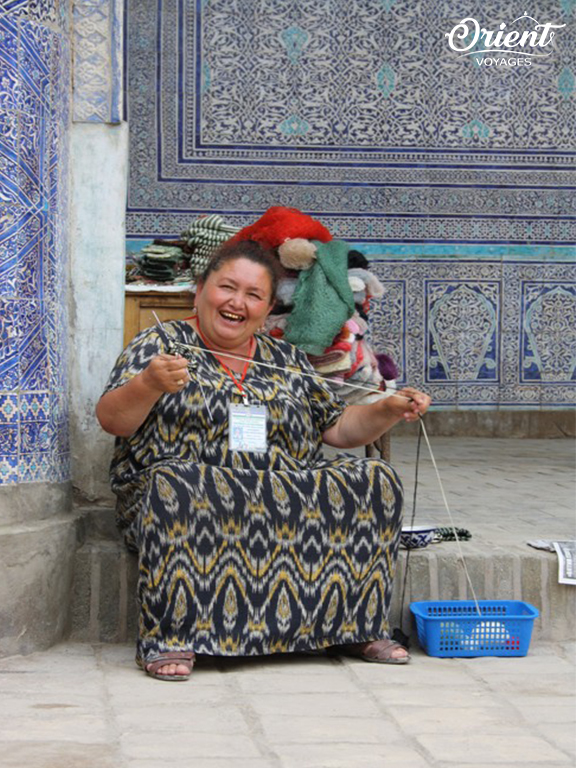-
Khiva, main gates Ota Darvaza
-
Khiva
-
Bukhara, Nodir Divan-Begi madrassah
-
Bukhara, Ark Fortress
-
Tashkent, Khast Imam Square
-
Bukhara
-
Samarkand, ensemble Shakhi Zinda
-
Bukhara, view on to Miri-Arab madrassah, XVI c.
-
Kyzylkum desert, riding on camels
-
Konigil village, silk paper center, noria
-
Sherdor madrassah, Samarkand
-
Samarkand, Registan Square
Tashkent – Symbol of Peace and Friendship
PAST AND PRESENT.
Throughout its 2200-year history Tashkent had passed a long way - from the ancient fortress, surrounded by a defensive wall, to one of the most beautiful cities in the world - the capital of Uzbekistan.
The largest economic and cultural center of Central Asia, Tashkent has an area of 320 sq km. It is located in the northeastern part of the country in the foothills of the Tian Shan Mountains at an altitude of 480 meters above sea level, in the oasis irrigated by the Chirchik river.
The first information about Tashkent as urban settlement appeared in deep antiquity. Many years of archaeological excavations have shown that the site of today's Tashkent was an ancient city, representing a developed commercial and cultural center of the East. Shashtepa hill fort is a settlement prior to the formation of the city; it is called the mother of Tashkent, and dates back to the V-IV centuries BC.
The city was mentioned by the Greek historian Herodotus (VI c. BC). The population of Tashkent oasis was called "Saks living behind Sogd", "behind-yaksart Saks." In the Chinese annals city was named Uni, Shi Chzheshi and described as the territory included in the state of Kangju. In the ancient chronicles Tashkent was also called Chach, Shash, Binket. In Russia of the XV century it was known as Tashkura. The modern name of Tashkent appeared at the beginning of the XI century, it goes back to the Turkic "tash" - stone and "Kent" - town (Stone Town). Since the times immemorial it was also called the "city of Turquoise". The Chatkal mountains located near Tashkent, are rich in this noble semi-precious stone and even lapis lazuli, jade, carnelian, which were exported to all the countries of the East.
History indicates that the foundation of Tashkent as a city falls on the II century BC; it was formed in the valley of the river Chirchik, 40 kilometers from the present city, on the border of the oasis and the steppe, as a meeting point of farmers and nomadic pastoralists for collaborative commerce in fertile climate. Here archeologists found sites of primitive communities of the Upper Paleolithic (40 -10 thousand years BC) and Mesolithic (10 thousand years BC).
The ruins of the ancient city are known as "Eski Tashkent" (Old Tashkent). Like other ancient cities of Central Asia, it was repeatedly moved in space and time. Its original nucleus (Shashtepa) arose on the southern edge of modern Tashkent. Ancient and early medieval city (Ming Urik) originated on the modern territory of train station. Binkat medieval town is located in the old city. Tashkent oasis occupied an important geographical position as a border area between Dashti Kipchak steppe (steppe areas of Western Siberia to the shores of the Dniester River) and agricultural oasis of Mawarannahr (between the Syrdarya and the Amu Darya rivers). There dwelled representatives of different ethnic groups and nationalities: Uzbeks, Kazakhs, Kyrgyz, Tajiks, Uighurs, Mughals, who were engaged in agriculture, animal husbandry and horticulture.
Major trade routes were lying through Tashkent - the "Great Silk Road" from China, "Golden Road" from Siberia, the way to India and Europe. Worldwide fame was the products of local metalworkers and gunsmiths, ceramic pottery, woolen fabrics and carpets, as well as gold and gems.
The territory of the oasis was in the midst of political events, and was attacked by the various states.
The fighting, clashes between nomadic tribes, then Kanguy (Khorezm) capture in the first century AD resulted in the city destruction, but in the III-IV centuries it became habitable again.
In the V BC Chach was conquered by Ephtalites - powerful country in Central Asia. In the VI century AD Eftalits State collapsed under the blows from the south and the Sassanid powerful tribes of Turkic Khanate in the north. Chach territory became part of the Turkic Khanate. The capital of the oasis moved to areas of Ming Urik, located in the bend of the Salar channel with a powerful defensive wall and castle (train station area).
In the early feudalism in the oasis there existed about 30 fortified cities, in the Arabic sources the capital was named Madina al-Shash (center of Chach). The heyday of the city belongs to the VII century, in the same period the city faced increasing competition for influence in the Chach between Turks and Arabs. City of Shash, as it was called by Arabs, was taken by them in 717, but after that the conquerors often made campaigns here to quell uprisings residents.
With the IX century, in the time of the Samanid dynasty, a new economic boom began in the towns of Shash. The capital moved from Ming Urik to the west of the canal Bozsu and Kalkauz, where there was a new town, which became the largest city of Shash called Binkat. It was divided into a citadel (arch), Inner City (shahristan or madina) and two suburbs – inner and outer rabats. Citadel had two gates, contained the ruler palace, treasury and prison. Period of the IX-XII centuries is called the "golden age", "Islamic Renaissance" in the history of economic and cultural development of Maweranahr, where Tashkent played a major role. This is the flourishing of crafts, trade, science and culture. Around the city in this period, there emerged a lot of gardens, castles and mansions of the nobility, among them - Tepe Shahnishin, Kukcha, Kallyahona, Tanyshyhar. On the outskirts of the city, especially facing the nomadic steppe were located border patrol fortresses.
In the early Middle Ages the capital Binkat was the center of different beliefs, in pre-Arab period, Zoroastrianism flourished here, there were also spread cults of agriculture and fertility, the people were familiar with Christianity, Buddhism and Manichaeism. With the arrival of the Arabs, Islam was spread among the population, Muslim religious buildings - mosques, minarets, madrassahs etc were built.
At the end of the X century, Central Asia was invaded by the Turks Karahanids, who shared the conquered territories into independent fiefdoms. Shash area with the main city, called Tashkent, was mentioned in the chronicles of the time.
In the XII century, at the time of the Mongol conquest, Tashkent experienced a period of decline, but by the XIV century, it had become a large populous and prosperous city.
In the XIV-XV centuries, during the reign of Amir Temur, Tashkent city regained importance of a strong, well-fortified fortress, with expanding territory, developing production of handicrafts, trade and culture thrive.
At the beginning of the XVI century Tashkent became a part of the first Uzbek state of Sheibanids. In the second half of the XVI century Abdullakhan II, after a long siege of Tashkent in 1580, ordered the destruction of the walls and set fire to the city. Over the next few years, the city was ruled by the Kazakh Khan Tevekkel, and then went back into the Bukhara Khanate.
From the XVIII century Tashkent was divided into four parts (daha). Each part had its own ruler (khakim). In 1784, Hakim of Sheikhantaur area, Yunus-khodja, united under his rule the whole city.
At the beginning of the XIX century Tashkent again lost its independence. It was captivated by the Kokand Khan. The territory of the city at that time was 16 square meters and a population of about 80 thousand people. Townspeople were engaged in trade, crafts and agriculture.
After the conquest of Central Asia by Tsarist Russia in the middle of the XIX century, Tashkent became the main city of Turkestan province. However, it is the center of political and cultural life. Trade with Russia played the important role in this period.
Since 1918 po1924 years Tashkent was capital of the Turkestan ASSR.
From 1930 to 1991 Tashkent was the capital of Uzbekistan.
After the collapse of the Soviet Union in 1991, Tashkent became the capital of the Republic of Uzbekistan. Today it is- the largest city in Central Asia with a population of over 2.2 million people, the most important political, economic, cultural and scientific center of Uzbekistan.
The largest economic and cultural center of Central Asia, Tashkent has an area of 320 sq km. It is located in the northeastern part of the country in the foothills of the Tian Shan Mountains at an altitude of 480 meters above sea level, in the oasis irrigated by the Chirchik river.
The first information about Tashkent as urban settlement appeared in deep antiquity. Many years of archaeological excavations have shown that the site of today's Tashkent was an ancient city, representing a developed commercial and cultural center of the East. Shashtepa hill fort is a settlement prior to the formation of the city; it is called the mother of Tashkent, and dates back to the V-IV centuries BC.
The city was mentioned by the Greek historian Herodotus (VI c. BC). The population of Tashkent oasis was called "Saks living behind Sogd", "behind-yaksart Saks." In the Chinese annals city was named Uni, Shi Chzheshi and described as the territory included in the state of Kangju. In the ancient chronicles Tashkent was also called Chach, Shash, Binket. In Russia of the XV century it was known as Tashkura. The modern name of Tashkent appeared at the beginning of the XI century, it goes back to the Turkic "tash" - stone and "Kent" - town (Stone Town). Since the times immemorial it was also called the "city of Turquoise". The Chatkal mountains located near Tashkent, are rich in this noble semi-precious stone and even lapis lazuli, jade, carnelian, which were exported to all the countries of the East.
History indicates that the foundation of Tashkent as a city falls on the II century BC; it was formed in the valley of the river Chirchik, 40 kilometers from the present city, on the border of the oasis and the steppe, as a meeting point of farmers and nomadic pastoralists for collaborative commerce in fertile climate. Here archeologists found sites of primitive communities of the Upper Paleolithic (40 -10 thousand years BC) and Mesolithic (10 thousand years BC).
The ruins of the ancient city are known as "Eski Tashkent" (Old Tashkent). Like other ancient cities of Central Asia, it was repeatedly moved in space and time. Its original nucleus (Shashtepa) arose on the southern edge of modern Tashkent. Ancient and early medieval city (Ming Urik) originated on the modern territory of train station. Binkat medieval town is located in the old city. Tashkent oasis occupied an important geographical position as a border area between Dashti Kipchak steppe (steppe areas of Western Siberia to the shores of the Dniester River) and agricultural oasis of Mawarannahr (between the Syrdarya and the Amu Darya rivers). There dwelled representatives of different ethnic groups and nationalities: Uzbeks, Kazakhs, Kyrgyz, Tajiks, Uighurs, Mughals, who were engaged in agriculture, animal husbandry and horticulture.
Major trade routes were lying through Tashkent - the "Great Silk Road" from China, "Golden Road" from Siberia, the way to India and Europe. Worldwide fame was the products of local metalworkers and gunsmiths, ceramic pottery, woolen fabrics and carpets, as well as gold and gems.
The territory of the oasis was in the midst of political events, and was attacked by the various states.
The fighting, clashes between nomadic tribes, then Kanguy (Khorezm) capture in the first century AD resulted in the city destruction, but in the III-IV centuries it became habitable again.
In the V BC Chach was conquered by Ephtalites - powerful country in Central Asia. In the VI century AD Eftalits State collapsed under the blows from the south and the Sassanid powerful tribes of Turkic Khanate in the north. Chach territory became part of the Turkic Khanate. The capital of the oasis moved to areas of Ming Urik, located in the bend of the Salar channel with a powerful defensive wall and castle (train station area).
In the early feudalism in the oasis there existed about 30 fortified cities, in the Arabic sources the capital was named Madina al-Shash (center of Chach). The heyday of the city belongs to the VII century, in the same period the city faced increasing competition for influence in the Chach between Turks and Arabs. City of Shash, as it was called by Arabs, was taken by them in 717, but after that the conquerors often made campaigns here to quell uprisings residents.
With the IX century, in the time of the Samanid dynasty, a new economic boom began in the towns of Shash. The capital moved from Ming Urik to the west of the canal Bozsu and Kalkauz, where there was a new town, which became the largest city of Shash called Binkat. It was divided into a citadel (arch), Inner City (shahristan or madina) and two suburbs – inner and outer rabats. Citadel had two gates, contained the ruler palace, treasury and prison. Period of the IX-XII centuries is called the "golden age", "Islamic Renaissance" in the history of economic and cultural development of Maweranahr, where Tashkent played a major role. This is the flourishing of crafts, trade, science and culture. Around the city in this period, there emerged a lot of gardens, castles and mansions of the nobility, among them - Tepe Shahnishin, Kukcha, Kallyahona, Tanyshyhar. On the outskirts of the city, especially facing the nomadic steppe were located border patrol fortresses.
In the early Middle Ages the capital Binkat was the center of different beliefs, in pre-Arab period, Zoroastrianism flourished here, there were also spread cults of agriculture and fertility, the people were familiar with Christianity, Buddhism and Manichaeism. With the arrival of the Arabs, Islam was spread among the population, Muslim religious buildings - mosques, minarets, madrassahs etc were built.
At the end of the X century, Central Asia was invaded by the Turks Karahanids, who shared the conquered territories into independent fiefdoms. Shash area with the main city, called Tashkent, was mentioned in the chronicles of the time.
In the XII century, at the time of the Mongol conquest, Tashkent experienced a period of decline, but by the XIV century, it had become a large populous and prosperous city.
In the XIV-XV centuries, during the reign of Amir Temur, Tashkent city regained importance of a strong, well-fortified fortress, with expanding territory, developing production of handicrafts, trade and culture thrive.
At the beginning of the XVI century Tashkent became a part of the first Uzbek state of Sheibanids. In the second half of the XVI century Abdullakhan II, after a long siege of Tashkent in 1580, ordered the destruction of the walls and set fire to the city. Over the next few years, the city was ruled by the Kazakh Khan Tevekkel, and then went back into the Bukhara Khanate.
From the XVIII century Tashkent was divided into four parts (daha). Each part had its own ruler (khakim). In 1784, Hakim of Sheikhantaur area, Yunus-khodja, united under his rule the whole city.
At the beginning of the XIX century Tashkent again lost its independence. It was captivated by the Kokand Khan. The territory of the city at that time was 16 square meters and a population of about 80 thousand people. Townspeople were engaged in trade, crafts and agriculture.
After the conquest of Central Asia by Tsarist Russia in the middle of the XIX century, Tashkent became the main city of Turkestan province. However, it is the center of political and cultural life. Trade with Russia played the important role in this period.
Since 1918 po1924 years Tashkent was capital of the Turkestan ASSR.
From 1930 to 1991 Tashkent was the capital of Uzbekistan.
After the collapse of the Soviet Union in 1991, Tashkent became the capital of the Republic of Uzbekistan. Today it is- the largest city in Central Asia with a population of over 2.2 million people, the most important political, economic, cultural and scientific center of Uzbekistan.
SIGHTS OF THE CAPITAL
The capital of Uzbekistan, Tashkent, is an amazing city of ancient history, beauty and hospitality. Today Tashkent is a city of contrasts, which arose at the junction of two civilizations - East and West, combining the construction of the medieval Islamic architecture and elegant European architecture of the XIX - early XX century. The new ultra-modern buildings have turned it into a unique piece of the largest Central Asian metropolis.
Boundary of the "old" and "new" city is the Anchor River, which crosses the city. Landmarks - madrassahs, mosques, mausoleums, located in the old part of Tashkent, amaze anyone who comes to the city with special beauty and harmony. You will be impressed by narrow streets with low adobe buildings perfectly fit with modern buildings.
Mausoleum of Sheikh al-Hovendi at-Takhur (Shayhantaur) is one of the most popular monuments of Tashkent. The memorial was built in honour of his uncle Sheikh Khodja Ahrar Shayhantaur (the XV-XIX centuries). Khodja Ahrar is the powerful head of the Sufi brotherhoods “Naqshbandi”. At the end of the XV century, next to the mausoleum of Sheikh was built the mausoleum of Yunus Khan, a descendant of Genghis Khan, and his grandfather Zahirrdin Babur (founder of the Mogul dynasty). Yunus Khan got his fame after conquest of vast territories of Transoxiana and Eastern Turkestan. The mausoleum was built in 1486 after the death of Yunuskhan by his sons. Main feature of the mausoleum were magnificent carved doors, they were musical - between their wings was cleverly built an ancient musical instrument chang.
To the north of the mausoleum of Sheikh al-Hovendi Takhur there is located the mausoleum Kaldyrgach-biy (XV c.). Both tombs include special premise - zierathona (place of worship and prayer reading) and gurhona (tomb).
Over time, around the Mausoleum of Sheikhantaur there formed a funerary complex, which in the XIX century was adorned with three mosques. Sheikhantaur Cemetery is the most popular holy place in Tashkent. Local aristocracy was buried here the XVI century. At the end of the XX - beginning of the XXI centuries on the territory of Shayhantaur Tashkent Islamic University was founded.
Tashkent attraction is also the biggest of the 23 madrassahs in the city, acting Kukeldash madrassah built in the XVI century, during the reign of the Uzbek rulers of Tashkent appanage - Barack Khan and Dervish Khan. Its builder was vizier of Tashkent khans (1551-1575), nicknamed Kukeldash ("foster brother of Khan"). For many centuries it was the focus of city life; at different times it served as a training institution, a caravanserai and even defensive fortress. Around the crowded noisy bazaar, criers shouted edicts of rulers and committed executions.
Madrassah is located on a high hill in the district of Chorsu. The main square of the old town - Chorsu was formed in the IX century. Trade routes led to it with all the city gates, and gradually developed into a shopping street. This area was the transportation hub and the main shopping area of Tashkent.
Of great interest is the religious center - the ensemble of Hazrat Imam (Khast-Imam). This is a set of magnificent architectural monuments of the spiritual culture of the country, located in a historic residential district of Tashkent - Sebzar. The complex was formed with the time around the tomb, where the first Imam was buried. He was the patron saint of the city, a preacher of Islam Kaffall al-Shashi, who lived in the X century. Mausoleum of the saint Kaffall ash-Shashi was built in the 50-es of the XVI century. Over the centuries, near the site of pilgrimage there arouse a group of buildings of spiritual culture. Thus, in the XIX century, near the graves, was built big Namazgokh Mosque, which today houses the Islamic Institute named after Imam al-Bukhari.
The same complex includes Barak-Khan madrassah, built in the XVI century, by the grandson of Ulugbek - Suyunij Khan. Here is the Muslim Board of Uzbekistan. It hosts a rich library of Oriental manuscripts with the collections of more than 30,000 books and manuscripts. It also keeps a famous Caliph Osman Koran, written in the middle of the VII century. This holy relic consists of 353 large sheets of parchment with the original text of the Koran.
The Hazrat square contains a magnificent Friday mosque, topped with sparkling turquoise domes and decorated with grand 56- meter high minarets. This is a modern building, producing a lasting impression, and made in the best traditions of Central Asian architecture in perfect harmony with a beautiful architectural ensemble of historic buildings.
Tashkent was a city of rich merchants and artisans, most of the major architectural structures were caravanserais, mosques and mausoleums.
Picturesque mosques: Jami Mosque (Juma, XVI c.), Mirza Yusuf (XIX c.) Hayrabat-Eshon (XVIII-XIX centuries) and Tilla Sheikh Mosque at Khast-Imam are very interesting from architectural point of view.
The mausoleums of Tashkent should be specially noted. They were built along trade routes in honour of saints. Mausoleums were not only places of worship but also a place of alms and trade. In Tashkent itself and along the roads leading to it, there remained about 10 of these mausoleums.
15 km south of Tashkent there is located a Muslim shrine - complex Zangiata (Zangiata - "dark father"). In the ancient cemetery there are two mausoleums - the mausoleum of the saint Sheikh Ai-Hodja and his wife Ambar Bibi, who was regarded as the patron of fertility and motherhood (XIV c.). Around it stretches a vast garden with monumental buildings of the XIV-XIX centuries. Sheikh Zangiata was a follower of the famous Central Asian Sufi Ahmad Yasawi. According to legend, the mausoleum was built during the reign of Amir Temur, who originally ordered to rebuild the mausoleum of another Muslim saint Ahmad Yassaviy in Turkestan (Kazakhstan). However, the wall being under construction was constantly crumbling and the process of building was neverending. Tamerlane had a dream that Yassaviy himself asked him to give due honours to Zangiata first. The governor ordered to erect the mausoleum of Zangiata, and only then a mausoleum of Ahmad Yassaviy was built in Turkestan.
Memorial buildings spread around a large garden, a complex of monumental buildings of the XIV-XIX centuries, madrassah (XVIII-XIX centuries.), mosque (1870) with a minaret (1914-1915.), and an ancient cemetery.
Zaynaddinbobo Mausoleum (XII, XIV - XVI, XIX century) is one of the most interesting and major monuments of Tashkent. It is dedicated to historical person - Sheikh Zaynaddin Kui Arifoni the son of the head of the Baghdad Sufis, "Sheikh of the sheikhs",who was said to have moved from Baghdad to Tashkent and lived in chillyakhona. After his death, the followers of Sheikh erected over his grave a small mausoleum (chortak), later it was rebuilt by order of Temur.
Visit the capital of Uzbekistan, will leave a lasting impression of the two thousand years of architecture, culture and art of this beautiful city. Today Tashkent is the political and economic core of Uzbekistan. Here, among the highest authorities of the country - the residence of the President, the Parliament of the Republic, ministries, departments, foreign embassies, are many industrial companies, factories producing airplanes and tractors, electronic devices, automatic control systems and communications facilities. Also in the city there are based enterprises of light, chemical, petrochemical, construction, food and pharmaceutical industries.
It is impossible to imagine a modern metropolis without the highest tower in Central Asia, the TV tower (375 m), without subway, built in 1972-1977 with the most beautiful stations, without the square with the monument to Amir Temur, near which there is located Museum of the History of the Temurids. A place of attraction and meetings in Tashkent are the well-known capital bazaars - Eski Juva and Chorsu market where you can buy not only the national souvenirs but taste fantastic food of multinational Uzbekistan in teahouses and cafes.
The city has universities and more than 20 higher education establishments, conservatories, academies of sciences and scientific research institutes. The city has a number of theaters, among them a special place is occupied by the Opera and Ballet Theatre, Navoi circus and "Uzbekfilm" cinema studio.
The rich historical past of the city and the country is reflected in the collections of many museums, the largest of which are the Museum of Arts of Uzbekistan, Museum of the history of peoples of Uzbekistan, Museum of Temurids, Applied Arts Museum of Uzbekistan, Museum of Literature, Alisher Navoi Museum, the Nature Museum of Uzbekistan, etc.
Tashkent is also called the "city of peace", "Oriental Star ", "city of bread", "symbol of peace and friendship", and it is not without reason. This multiethnic city, known for its tolerance, has churches and temples of different faiths and confessions.
Thousands of tourists and business people visit Tashkent every year to get a lasting impression of the landmarks and ancient Uzbek culture.

Review 

Dear Sirs,
Good evening,
I write to you after we returned from Uzbekistan, back to Egypt .
This is to thank you and your company for the memorable trip you planned for us.
We ...
all reviews
all reviews













